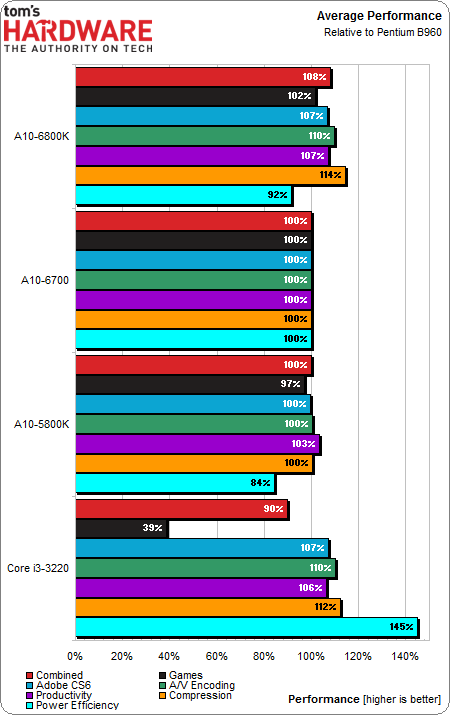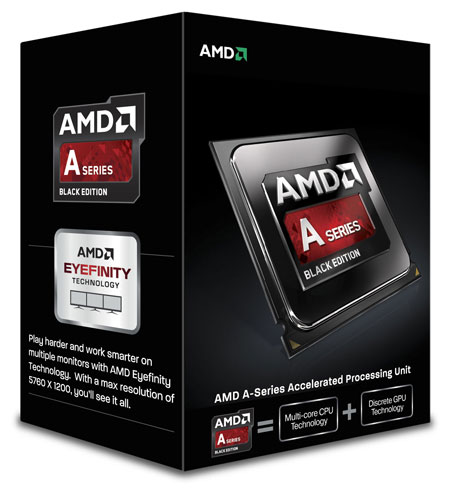AMD A10-6700 And A10-6800K Review: Richland Hits The Desktop
Richland, code name for AMD's highest-end APUs, finds its way into our lab in the form of A10-6700 and A10-6800K. Based on the Piledriver architecture and VLIW4 graphics, these chips are slight improvements to Trinity. Can they outshine Core i3, though?
As Expected, Richland Is A Little Better; Not Massively So
The following chart reflects aggregate performance of the four CPUs we tested. The red bar is the average of all benchmark performance categories, and the aquamarine bar gives us average power efficiency.
If you took the time to flip through our individual benchmark results, none of these results should surprise you. The A10-6700 offers similar performance as a stock A10-5800K, but offers greater efficiency. Unfortunately, it's also multiplier-locked. I have to believe that if you're willing to spend $150 on a 65 W A10 that can't be overclocked easily, then you're probably better off with a 55 W Core i3 that's also stuck in place for $10 less.
How about the unlocked models? AMD's A10-6800K is slightly faster than the -5800K it succeeds, roughly matching the Core i3-3220 in applications, while killing its HD Graphics 2500 engine in games. Based on performance data generated in The Core i7-4770K Review: Haswell Is Faster; Desktop Enthusiasts Yawn, we also know that an A10-5800K's graphics component is faster than HD Graphics 4000 and HD Graphics 4600. Unless Intel finds a way to get its higher-end graphics configurations on desktop processors, AMD's APUs maintain their top position for mainstream gaming.
The Intel chip's performance in single-threaded apps is exceptional. It holds its own in more parallelized workloads. And it offers the best efficiency, without question.
At the end of the day, AMD's Richland design is an iterative evolution of the Trinity architecture. It's not a game-changer. The only real surprise in this story is that, complemented by 2133 MT/s memory, the A10-6800K manages to elbow past the same processor with a discrete Radeon HD 6670 DDR3 installed. That's what we consider an entry-level gaming card, so the APU's achievement is a significant one. A quick price check shows that dual-channel, 8 GB, 1866 and 2133 MT/s kits start around $70. Armed with that, you can get low-end game performance without spending more on a graphics card. Consider this a landmark of sorts; a number of games are playable at reduced details using Richland-based parts, just as they were with Trinity.
Of course, when you have a little more money to spend, we also see that the Core i3's x86 cores allow even cheap graphics cards to performance closer to their peak potential without imposing a bottleneck. As far as gaming goes, then, the APUs fill a fairly narrow niche, above which you're better off with an add-in GPU and fewer restrictions on the settings you can use.
Calling Richland a stopgap between Trinity and the next-gen Kaveri would be just about right. From what we hear, Kaveri should still land sometime late this year. So, although Intel took a big step in catching up to AMD with its HD Graphics 4600 engine, the integration of GCN should help AMD widen that gap again. Steamroller-derived x86 should help as well, as should the implementation of hUMA (heterogeneous unified memory architecture). Unfortunately, Kaveri requires a new socket interface, so it won't be an upgrade path for anything with Trinity or considering Richland.
Get Tom's Hardware's best news and in-depth reviews, straight to your inbox.
Current page: As Expected, Richland Is A Little Better; Not Massively So
Prev Page Results: Power ConsumptionDon Woligroski was a former senior hardware editor for Tom's Hardware. He has covered a wide range of PC hardware topics, including CPUs, GPUs, system building, and emerging technologies.
-
esrever Numbering has never been for the architecture inside the chips. They have always been marketing for the current line of products. Normal people buy a laptop, they see the number, they get the performance associated with said number and they don't care about the inside of the chip. Richland is just a trinity refresh with better power management and higher clocks.Reply -
-Fran- No temps with power metrics page? 8(Reply
I guess Richland is still very hot going by the power figures alone. Still, it's a good step up (and stop gap) for AMD.
Nice review still. Are you guys planning on a follow up for Dual Graphics? 8)
Cheers! -
Wes Young Reply10920935 said:This is dumb. Still 6670 max card for dual graphics. Disappointing.
No, since driver 13.1 even the 5800k was able to run dual graphics with a HD 7750. I am typing on a system with that exact setup right now. I am not sure if the 6800k will allow anything above the 7750 though. When I tried a 7770 with the 5800k I wasn't given the option to enable dual graphics.

